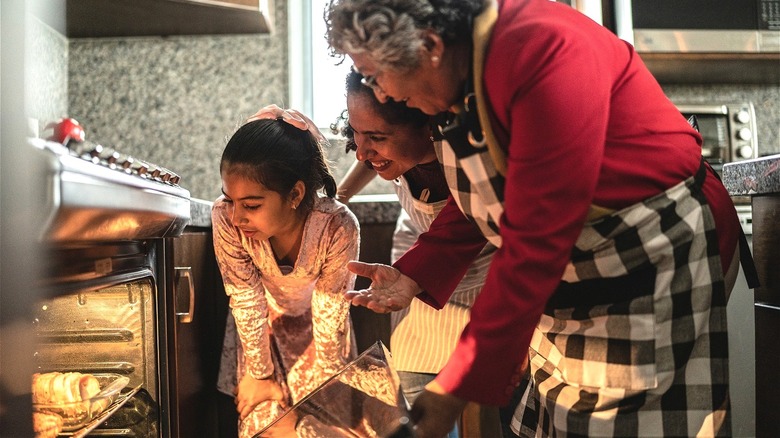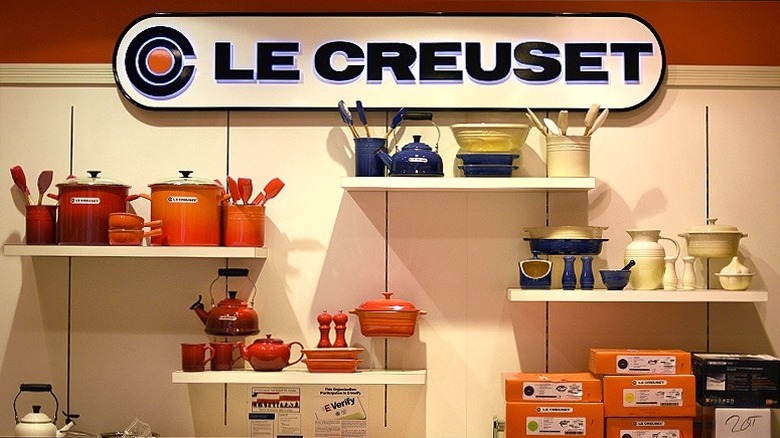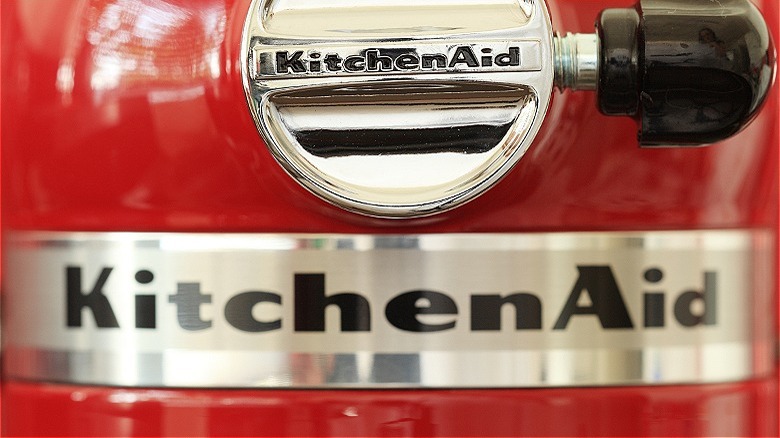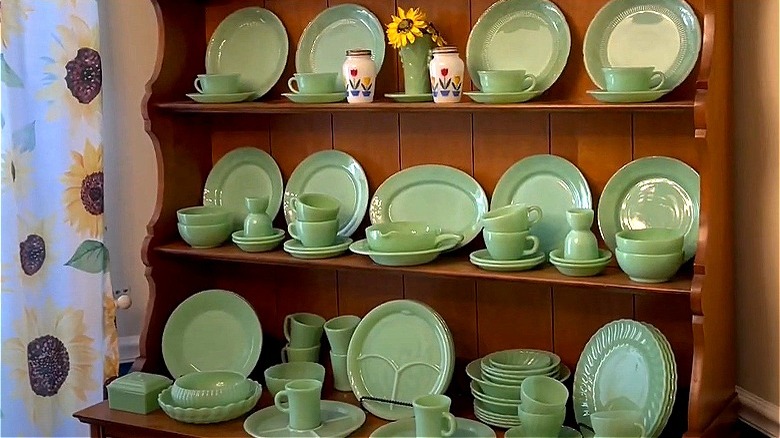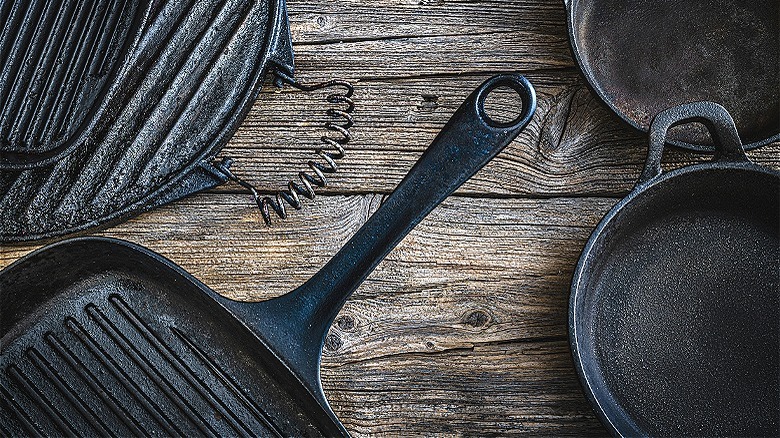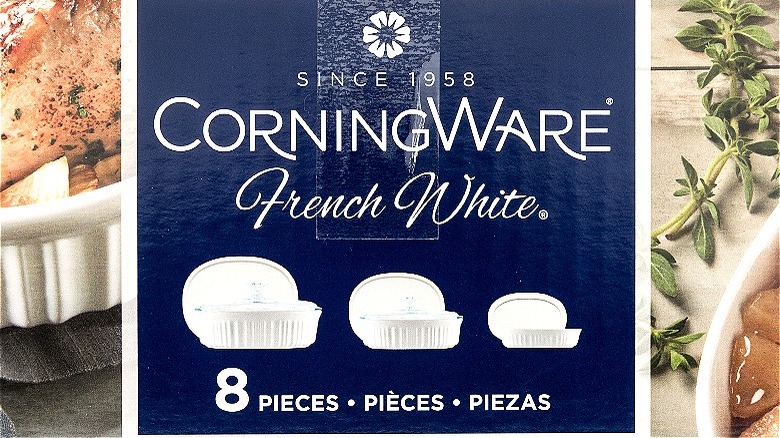These Old Kitchen Items Are Worth A Ton Of Money
While, depending on the study, only 30% to 50% of American families manage to eat their meals together on a regular basis, there's a much larger agreement on the importance of family meals, with a majority of Americans cooking at least some or most of their meals at home. The kitchen's where you learn to cook, after all, and make memories in the process, sometimes using old kitchen items passed down from the generation(s) before.
That said, the kitchen could potentially be a way to make some money, too, and not by converting your home into a restaurant. There's a thriving resale market for cookware, for use and for display, and vintage and/or antique items can be worth quite a bit. Vintage copper pots to decorate a kitchen, vintage Tupperware to store food, and vintage cast-iron skillets to cook with can go for hundreds or even thousands of dollars today.
You shouldn't expect to earn that much for just any piece of kitchen gear you have on hand that's gotten on in years, of course. Brand, condition, and appearance all affect the value of an old kitchen item, much like a favorite vinyl record that's worth a ton of money today or collectible Happy Meal toys, a PEP cereal box, or newer Funko Pop! figures people may not have thought would increase in value with time. As for those old kitchen items, here are a few you might have on hand that could fetch an impressive price on the market.
Le Creuset enamel cookware
Cookware manufacturer Le Creuset prides itself on its color. It's been in the business of making enameled cast iron since 1925, when it launched the "Flame" color that's become synonymous with the brand. A bright orange-red, Flame was initially the only color Le Creuset enamel came in. The company later issued its wares in a wide range of hues and manufactured them as a style statement as much as a necessity for the kitchen. Brand-new Le Creuset can sell for hundreds of dollars; some collectors even recommend picking it up slightly used, to shave a few bucks off the price.
A little wear and tear isn't enough to put, say, a Le Creuset Dutch oven out of commission; when well-cared for, they can be used for decades. Further, age doesn't always knock down the value. For one, the company has gone through a lot of colors in its time, some of which have been discontinued (making them rare and collectible). And design changes have moved the handle from an integrated part of the lid to a separate black knob. A vintage piece, even with a bit of damage, can sell for around as much as brand-new Le Creuset at auctions and vintage shops.
Vintage KitchenAid mixers
KitchenAid is still making blenders, refrigerators, cookware, and other kitchen essentials today. But the home-appliance brand got its actual start with a mixer. Herbert Johnson of the Hobart Corporation developed an automatic mixer in 1914 to make baking bread more efficient. His initial clientele was the United States navy, but by 1920, it was being marketed to the public under the KitchenAid name. The rival product Sunbeam MixMaster was the favored choice among consumers until the late 1930s, when KitchenAid's streamlined Model K mixer put it over the competitive edge. Both the aesthetic and functional standards set by the Model K have changed little since.
Production of the Model K was suspended during World War II, but took off rapidly once the war concluded. One of its most appealing traits, one that has endured to this day, is the interchangeability of its attachments, which can be used on any KitchenAid mixer. What's more, the postwar period added an additional appeal by making models available in a wide range of colors compared to the initial standard white.
The Model Ks made between the '30s and '50s have proven incredibly durable, and collectors are keen on them. Lindsey Chastain of sustainable homesteading blog The Waddle and Cluck told Best Life Model K mixers from that period can sell for hundreds, even thousands, of dollars. Chastain quoted a $5,000 price for one at auction.
Jadeite dishware
Dishes, like clothes, cars, and architecture, have their fads and trends. Jadeite, a mint-green milk glass that shares its name with the mineral, caught on as a popular material for American cookware during the Great Depression (speaking of which, here's a list of the richest people during the Great Depression). Initially used for cooking tools (and made, by at least one company, with uranium), they were eventually turned into a popular line of dinnerware items during World War II. This brand of jadeite, made by Anchor Hocking under its Fire King label, reached the zenith of its popularity during the 1950s and was manufactured until 1974.
Reproduction jadeite is still made today, and at affordable rates. But collectors looking for vintage wares, or owners looking to sell theirs, can distinguish older jadeite by the manufacturer's mark (three companies were primarily responsible for jadeite in its early period and heyday), embossed patterns, and, for prewar jadeite, a black-light glow due to the uranium present in the glass. Vintage jadeite is a popular collectible and found in all sorts of markets. The condition of the dishes wildly affects their price. Fire King jadeite can sell for as little as $5 or as much as $1,000, and pristine limited-manufacture pieces can go north of $5,000.
Vintage cast-iron skillets
Those who cook on a regular basis need hardy cookware, and a good cast-iron skillet is made to last. A modern pan that sells for around $40 can last for years to even decades. But there's a high demand for vintage cast-iron cookware, and not just for novelty's sake. Wares made in the 19th and early 20th centuries were crafted by hand, and they can be restored and seasoned for use as well as display. Cast iron is a popular item in antique shops and can also be found in thrift stores, at auctions, and online. Prices on vintage iron cookware range from near-new prices to thousands of dollars. A rare piece branded by a spider design, for example, sold for $8,000 on eBay (via Southern Living).
That particular skillet was a one-of-a-kind piece made by Griswold Manufacturing, hence the high value placed on it. But even for less rare items, Griswold's cast iron is among the most valued. The manufacturer is among the factors that go into determining cast iron's worth, along with condition, size, age, and type of cookware. Condition is a more important factor than you might expect at first, even if the cast iron is meant for collection rather than cooking. As CBS put it, "If it isn't fit for cooking, it isn't fit for collecting."
CorningWare pieces
Pyroceram, a glass-enamel material trademarked by Corning (in 1958), was discovered by accident. Its inventor, S. Donald Stookey, accidentally overheated a piece of photosensitive glass, only to find it had gone white, retained its structure ... and didn't break when dropped. The resulting product was originally put to military use, but Corning later used it in a line of cookware it dubbed CorningWare. These dishes, made in a variety of shapes and sizes, could be used for cooking, baking, freezing, or serving.
Pyroceram was later phased out in favor of stoneware, but vintage CorningWare is still coveted by some cooks. It's a common item in thrift shops and auction sites, often at very cheap prices. But sets and even individual dishes that had unique and limited-edition designs instead of the standard blue cornflower can be very valuable. A 1970s piece with a pattern that didn't sell well on initial release fetched $7,000 in an eBay auction (via a 2014 story in the Chattanooga Times Free Press). And even some cornflower dishes, if they're old enough and in good enough condition, can command a high price. Sellers on Etsy have listed 1950s CorningWare for $23,000.
